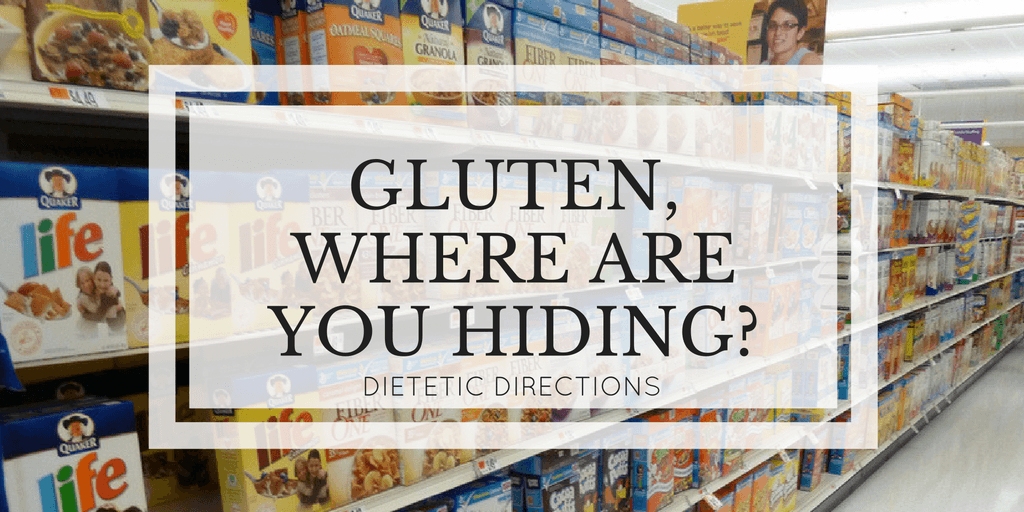
Gluten, where are you hiding?
If you are a member of the population avoiding gluten (protein found in wheat, rye, barley and contaminated oats) you are not alone on your journey! In fact, you are also not alone if you have an overwhelming feeling that gluten could be subtly hiding where you least expect it! Sound familiar? If so, this article is for you 🙂
First, for those on a Gluten Free (GF) diet, the importance of LABEL READING each and everyproduct label every time cannot be over-emphasized!! Even if you previously purchased a product (let’s say a brand of rice crackers) and checked the label to determine that it is a ‘safe’ GF product, you STILL NEED to read the label when you purchase the same product again. Manufactures can change ingredients (possibly adding wheat flour to those crackers) at any time and without consumer notice. In the above example, adding wheat flour to the rice crackers would mean that the product now contains gluten and would no longer be safe for ingestion on a Gluten Free diet.
For those with celiac disease, an autoimmune condition where the small intestine is severely damaged with gluten ingestion, the habit of regularly checking food labels is necessary to avoid uncomfortable symptoms (gas, bloating, diarrhea etc).
GOOD NEWS:
Canada’s new Food Allergen Labeling Regulations came into force on August 4, 2012. This is great news! Now, as a consumer, you will be able to tell if a product contains gluten in simple language by looking to the product ingredient list. You may see a parenthesis after the ingredient stating “gluten or wheat” or there may be a “CONTAINS statement” below ingredient list. For example, Contains: peanut, soy, gluten. This means that now, Modified Food Starch listed as ingredient, will have to identify if it contains gluten. This saves us from calling the food companies.
When hunting for hidden gluten, think beyond the obvious sources like breads, cereals, pastas and baked goods.
Below is a list of foods you may encounter at the grocery store. Keep an extra close eye since these products may have gluten and are often ‘less suspected’ by the consumer. This list is not exclusive and some products listed do not need to be avoided if they come in gluten free varieties.
Grocery Store:
- Be wary of sauces, gravies and salad dressings (these are often made with wheat protein or wheat flour for thickening)
- French fries: Again, READ LABEL – some have wheat flour dusting and therefore contain GLUTEN
- Canned soups (check, check, check!)
- Ice creams, sherbets, gelatos (dido)
- Deli Meats
- Often cereal filler or modified food starch
- Candies (licorice, jelly beans, candy corn etc) Note: If no ingredient list on the wrapped candy don’t eat it!
- Soya Sauce (some are GF but many contain wheat)
- Hot chocolate beverage (often wheat starch)
- Yogurts (may have cereal grains or wheat starch as an ingredient)
- Pre-basted meats (ex. Turkey) (check ingredients because often wheat in basting sauce)
Here is an unusual one; there may be hidden gluten on stamps and envelopes! It is the wheat starch that makes the envelopes sticky! So when in doubt, use a wet sponge instead. Hair spray is another unsuspecting source that may contain gluten and cause adverse reactions. Read those ingredients on these product too. Also, lipsticks!
Does Wheat Free mean Gluten Free?
Wheat free does NOT mean Gluten free. If a product is wheat free (ex. Rice Krispies original) that does not necessarily mean that it is GLUTEN FREE since gluten includes all forms of wheat, rye, barley and contaminated oats. These Rice krispies contain malt flavouring which is a form of barley (therefore, not GF but free of wheat). To be clear, celiacs must avoid all forms of GLUTEN, which includes wheat but is not limited to only avoiding wheat (avoid barley, rye and oats). To be sure, read the food label and question the foods marked as ‘wheat free’ since they are not necessarily gluten free!
Bottom Line
Always check the food labels! I hope I am not repeating myself 😉 Feel confident that food companies will label gluten if it is used as an ingredient in plain and simple language on the label. Call food companies to question manufacturing processes and risk of cross contact. Speak to a registered dietitian for assistance in following this diet. Last, plain, unprocessed meats, cheeses, vegetables, fruits and milk products are naturally all gluten free. So enjoy!


